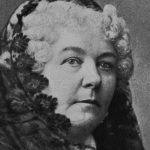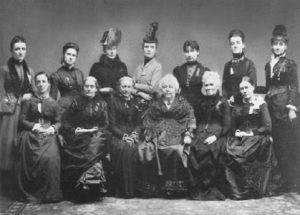Feminist Firebrand
submitted by Betty McLellan
Elizabeth Cady Stanton has been described as, among other things, a “feminist firebrand” who worked tirelessly for women’s rights for more than 50 years. As such, she is a hero of mine.
From a wealthy privileged family, she studied at Troy Female Seminary in New York and is reported to have had a “good mind and ready wit”. She was a gifted and powerful speaker and wasn’t afraid to express her opinions in the Anti-Slavery movement, the Movement for Women’s Suffrage, and women’s rights in general.
THE WOMEN’S BIBLE. I was “introduced” to Elizabeth Cady Stanton when I came across The Women’s Bible published in two volumes – 1895 and 1898 – written by Stanton and the Revising Committee which was made up of 20 women from the United States and five from other countries. It’s a wonderful, outrageous piece of work, critiquing the Bible and pointing out the part that organised religion played in denying women their full rights.
 In the Introduction written by Stanton herself, she addresses the men of the church who are totally resistant to change:
In the Introduction written by Stanton herself, she addresses the men of the church who are totally resistant to change:
“Come, come, my conservative friend, wipe the dew off your spectacles, and see that the world is moving… Others say it is not politic to rouse religious opposition. This much-lauded policy is but another word for cowardice. How can woman’s position be changed from that of a subordinate to an equal, without opposition, without the broadest discussion of all the questions involved in her present degradation?” (1895, pp. 10-11).
After the Introduction, the Revising Committee critiques (fairly ruthlessly) many of the books of the Bible. That part of the Creation story in Genesis Chapter 3, where Adam and Eve sinned against God – by taking the forbidden fruit from the “tree of the Knowledge of Good and Evil” – is a worthy example. This is what they write:
“Reading this narrative carefully, it is amazing that any set of men ever claimed that the dogma of the inferiority of woman is here set forth. The conduct of Eve from the beginning to the end is so superior to that of Adam….
“Then the woman fearless of death if she can gain wisdom takes of the fruit; and all this time Adam standing beside her interposes no word of objection… he takes the fruit from the hand of his wife without a protest…
“The subsequent conduct of Adam was to the last degree dastardly. When…Jehovah God appears to demand why his command has been disobeyed, Adam endeavors to shield himself behind the gentle being he has declared to be so dear. ‘The woman thou gavest to be with me, she gave me and I did eat,’ he whines – trying to shield himself at his wife’s expense! Again we are amazed that upon such a story men have built up a theory of their superiority!” (pp. 26 -27).
It’s interesting to note that all of the work required to produce The Women’s Bible was undertaken just a few years before Stanton died. Born in 1815, she was 80 years of age when the first volume was published and 83 when the second was published. She died in 1902, aged 86.
EARLIER YEARS. Her earlier years were just as eventful. In 1840, Elizabeth Cady married Henry Brewster Stanton (omitting the word “obey” from the marriage ceremony). In addition to bringing seven children into the world, they worked tirelessly together for the abolition of slavery in the US.
Her particular focus on women’s rights began in 1848 in Seneca Falls, New York, when she organised (together with Martha Coffin Wright, Mary Ann McClintock, Lucretia Mott and Jane Hunt), the First Woman’s Rights Convention. Out of this landmark convention came the Declaration of Sentiments, co-authored by Elizabeth Cady Stanton. In the introduction to the 20 Sentiments, Stanton inserts the word “women” into the well-known beginning sentence of the United States Declaration of Independence:
“We hold these truths to be self-evident; that all men and women are created equal; that they are endowed by their Creator with certain inalienable rights; that among these are life liberty, and the pursuit of happiness.”
As a preface to the Sentiments, Stanton writes:
“The history of mankind is a history of repeated injuries and usurpations on the part of man toward woman, having in direct object the establishment of an absolute tyranny over her. To prove this, let facts be submitted to a candid world.” (The Sentiments and the names of all the women and men courageous enough to put their signatures to the document can be found at https://www.nps.gov/wori/learn/historyculture/declaration-of-sentiments.htm).
MIDDLE YEARS. After the Seneca Falls Convention and the Declaration of Sentiments, Stanton continued to write and lecture on women’s rights, the abolition of slavery and the importance of temperance. In the early 1850s, she worked with Susan B Anthony promoting women’s rights and, in particular, the right to vote. Together they formed the National Woman Suffrage Association in 1869 with Elizabeth Cady Stanton as its first president.
 PUBLICATIONS. Throughout her very busy life, Stanton found the time to write several books:
PUBLICATIONS. Throughout her very busy life, Stanton found the time to write several books:
. History of Women’s Suffrage. 1881-1922. Vol. 1 – 3 (with Susan B Anthony and Matilda Joslyn Gage), and Vol. 4 – 6 (completed by other authors after her death).
. Solitude of Self. 1892.
. The Women’s Bible, 2 volumes. 1895 and 1898.
. Eighty Years and More: Reminiscences 1815-1897. 1898.
Elizabeth Cady Stanton will always be a feminist hero of mine – a feminist foremother. Her wisdom and intellect; her self-assurance and assertiveness; her courage and determination in the face of incredible opposition from patriarchal institutions and those who benefited from them, is an example to us all.
Here, in the 21st Century, the fight against patriarchal arrogance goes on and, like Elizabeth Cady Stanton, we must position ourselves at the forefront.
